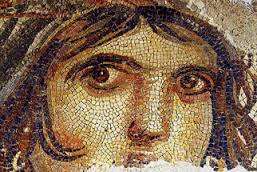Ever since the ancient Greeks, Romans and Byzantines have ascertained the medium of mosaic, its practice made its way through medieval Western Europe to finally reach the Islamic world and Eastern Europe.
Throughout the modern period, mosaic art was being revived within the Arts and Crafts movement. The hallway of rebirth continued its extension with modern architects and artists transforming the medium into a futuristic fantasy. One of these architects is the practitioner of Catalan Modernism, Antoni Gaudi who brought mosaic art towards its current international forefront. He considers every inch and element of his creations and integrates materials such as ceramics, glass and marble tiles into his architectural designs. One of the main reasons mosaics were integrated into architecture, was to bring art to the science. The flat and smooth texture of tiles and their perpetual hardness were well suited to the aesthetics of modern architecture.
Mosaic Art in The Roman Empire
During the Roman Empire, mosaic art attained its iconic splendour. The Romans were not the first people to use the medium, however the ones who improved it. Figures of the Roman Empire were a common trait ornamenting floors, villas and public buildings. Mosaics were a vehicle of expression, portraying Roman activities like gladiator conquests and hunting scenes. The medium also portrayed the Romans themselves in detailed and realistic portraits. Although the tradition of making mosaics dates back to the beginning of mankind, we can’t consider it in a modern sense. Egyptian walls were often ornamented with coloured stones implanted with plaster. However, Romans created a new way of crafting mosaics. They replaced the pebbles in the panels with small blocks of coloured stones. They also grouted the gaps with lime mortar, to make their murals more durable. Some of their murals were destroyed during wars, while others are being discovered time and time again through excavations all over the world.
Read More About Roman Mosaic Discoveries.
Mosaic Art in The Byzantine Empire
With the rise of the Byzantine Empire, mosaic art attained new levels of creativity, perspective and technique, becoming a main aspect in Byzantine architecture. The Byzantine Empire became the core of Christianity, attracting a huge amount of Roman and Greek craftsmen and artisans. Throughout the Byzantine Empire, new smalti glasses were produced with substantial sheets of coloured glass. The technique consisted of leaving smalti tiles with no grout, to create a light reflection within the glass. In the beginning of the 6th century, Byzantine artisans expanded a new method of setting glass tiles. They used a range of heavy duty resins at a sharp angle, in order to reflect even greater light. The finest Byzantine mosaics mostly depicted Biblical and Liturgical subjects. Today, Byzantine mosaics are festooned with gold leaf and gleaming glass tiles. The figures are symmetrically created with a dimness of emotional individualism, manifesting calm faces.
Mosaic Art in The Islamic World
After the Muslim invasion of the Eastern provinces of the Byzantine Empire, Islamic architecture was influenced by the Byzantine architectural techniques. Islamic architecture of Asia and North Africa used mosaic techniques to decorate religious buildings and palaces. Islamic artisans and craftsmen took a fundamentally different perspective towards mosaic art, compared to European mosaicists. Clay and smalti glass were used to create complex patterns, whereas in the Byzantine era they had been used to create larger recognisable figures. Islamic mosaics manifest tessellations: periodic tiling with repetitive patterns and geometric designs with no overlapping gaps. Mathematicians were marvelled by the complexity and precision of the geometric mosaic patterns. After the 8th century, mosaic art went out of fashion in the Islamic world for a while.
Mosaics Through The Art Nouveau Movement
As the 19th century gave way to the 20th , the rise of the Art Nouveau movement reawakened the interest in mosaic designs. Art Nouveau was a movement that linked decorative arts with architecture. The movement embraced mosaic art, through the workmanship of Antoni Gaudi and Joseph Maria Jujol, who both envisioned the heavenly scenario of Parc Güell. Their mosaic technique was known as the trencadis technique, in which tiles cover the surfaces of buildings.
Nowadays, Art Nouveau is considered as a modernism walkthrough Neoclassicism. Many Art Nouveau monuments entered the UNESCO World Heritage List, contributing to the countries’ cultural heritage.
Mosaic Art in The Early 21st Century
During the 21st century, mosaic art remains in the spotlight. The medium today is still in a bracing process, where new ideas are born every day. The British Association for Modern Mosaics and The Society of American Mosaic Artists exist to uphold the mosaic bridge walk-through artworks, architecture and beyond!
Source: http://www.arquitecturaorganica.com
Throughout the centuries, the medium has been creatively limitless. Artists used many fascinating and unpredictable materials to weld an expressive mosaic, known as the “Vehicle of Expression”.
Artists today are subsequently giving an innovative coil to this ancient medium. Mosaic creations are representing the futuristic vision of mosaic artists throughout human civilisation. In the late 21st century, we forecast the birth of an artistic generation broader than any other through history. Mosaics will become the vehicle of dialogue between modern audiences and modern limits.










